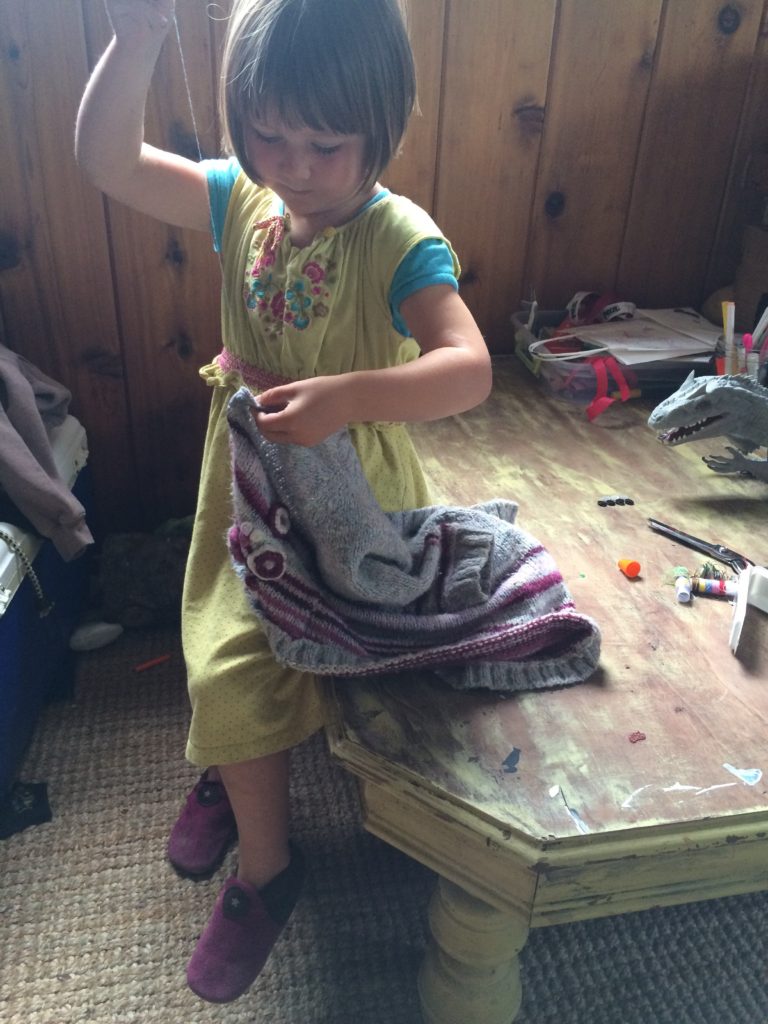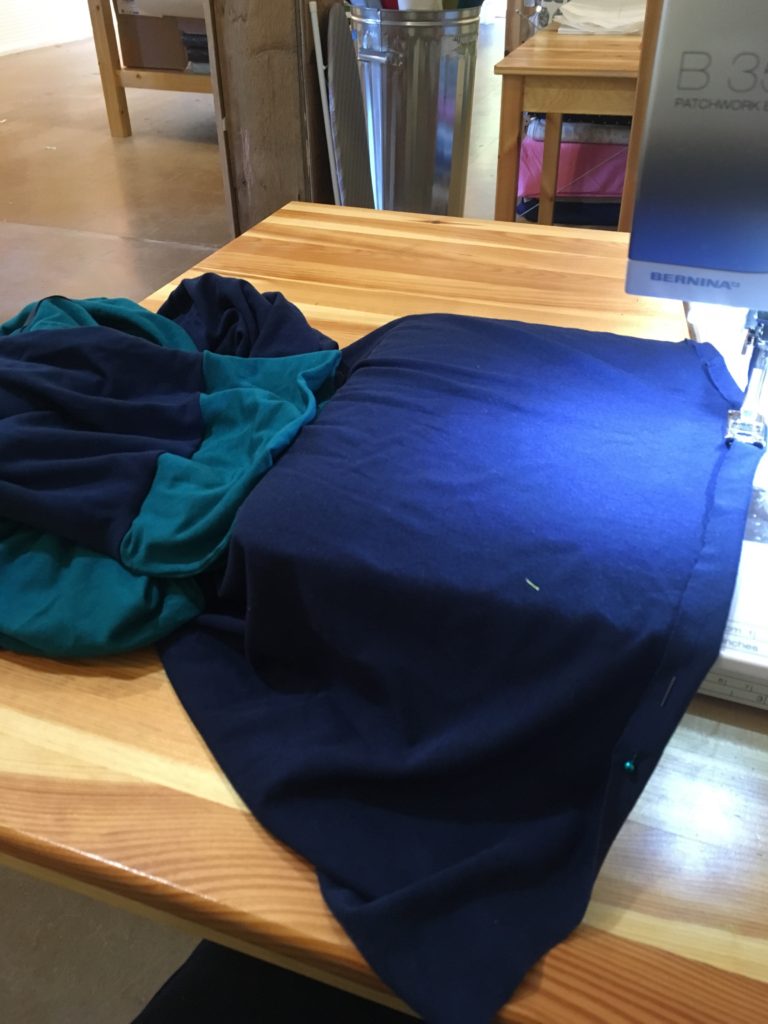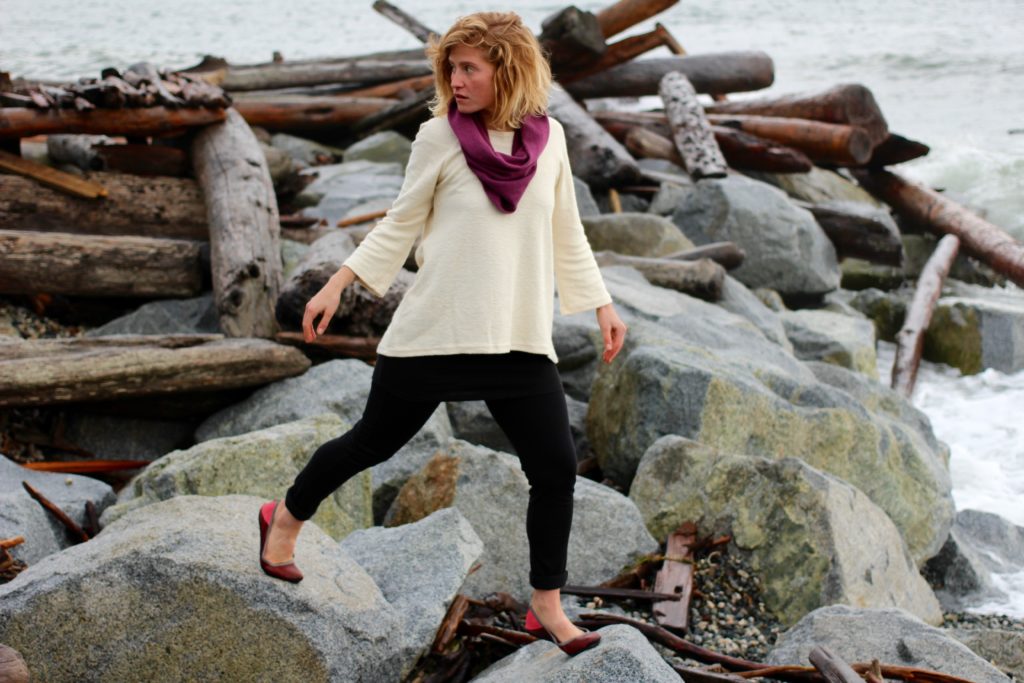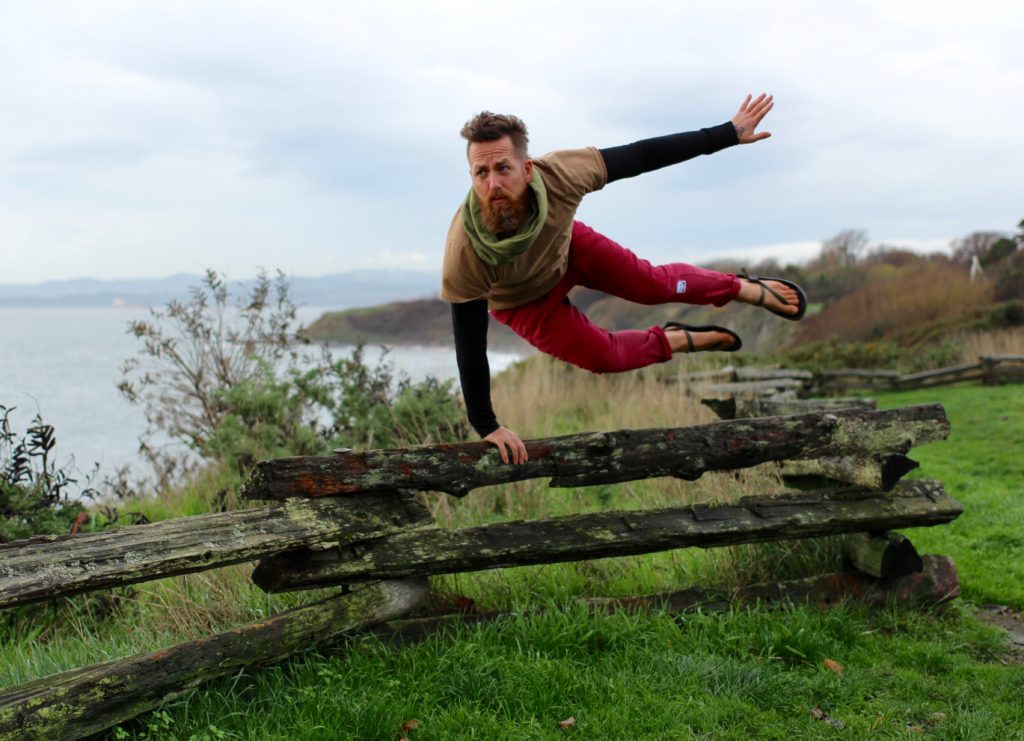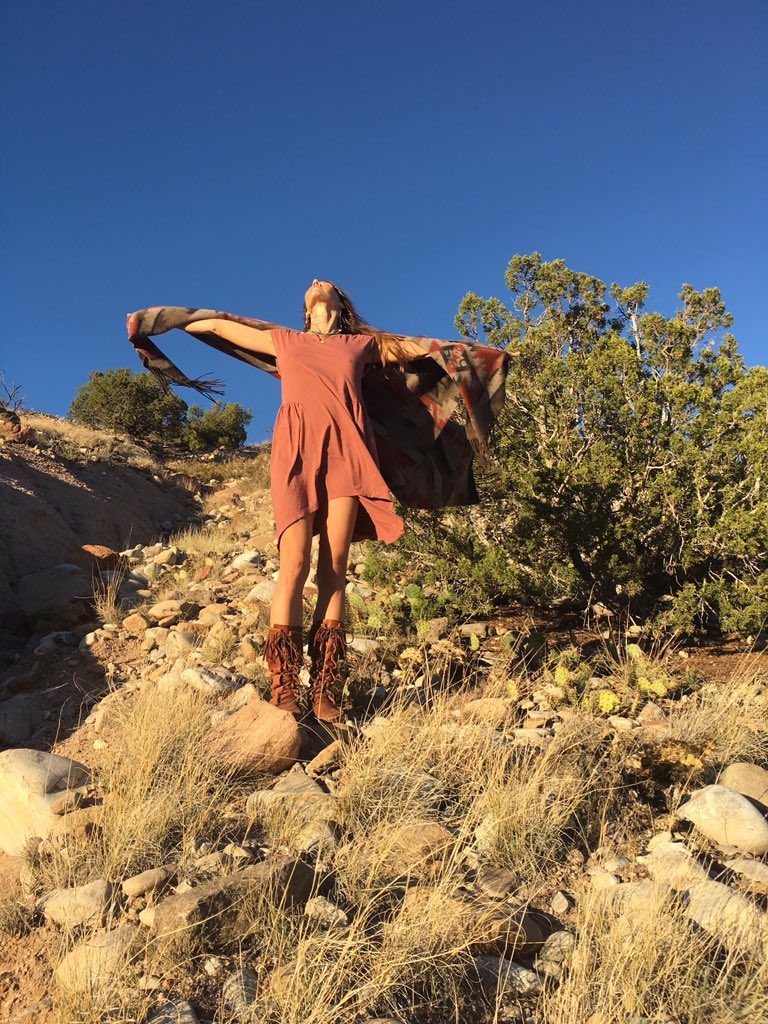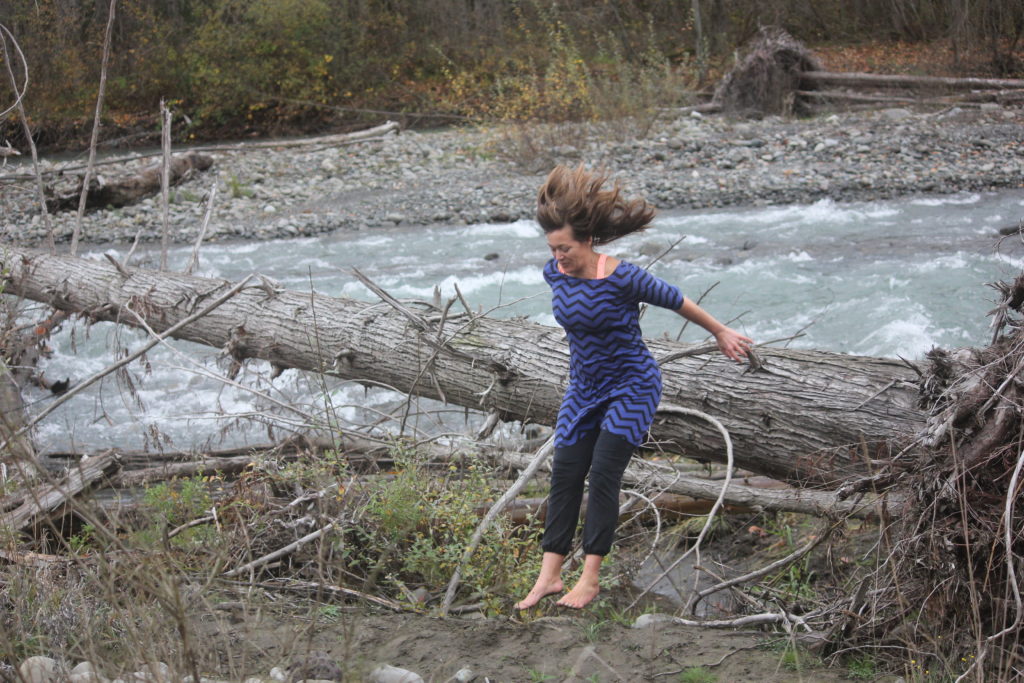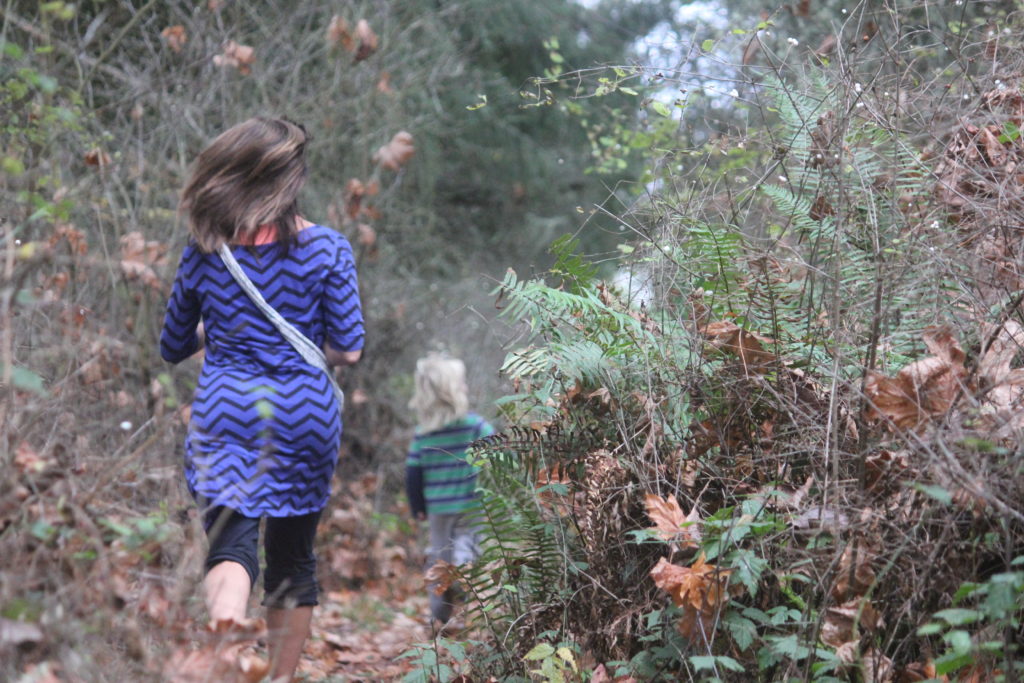Movement Matters is a book about the role our personal movement plays in the world. That is, how much movement is required for our survival and how much of it have we outsourced to others? This post is part 2 in a series providing even more actionable items we can choose to take, personally, specific to different topics addressed in the book.
I’ve never hidden my love of comfortable, stretchy workout clothes. Bendy pants, sports bras, and track suits…all super comfortable. But here’s the thing: If you’re going to refer to part of your wardrobe as “exercise clothes,” (or yoga/running/workout gear), then you have to acknowledge that everything else in your wardrobe is “sedentary clothes.” Meaning, part of what you’re choosing to wear each day is preventing you or parts of you from moving. This is one of the reasons many have transitioned to barefoot and minimal shoes. Here’s where I ask you to expand that understanding of the limitations overly stiff, movement-limiting footwear places on your physiology to include what we’re putting on our legs, around our waists, and across our backs (listen to this podcast episode on clothes that move you). But we can think broader still: clothing can limit our movement and vice versa—our lack of movement is playing a role in what we’re choosing to wear.
With the exception of a few beaches here and there, clothing has become a requirement most minutes of our lives. In the same way we’ve become separated from the source of our food—we don’t exchange much personal movement for what we require and we’re often unaware of who is doing these movements and in what situations—we’re almost entirely disconnected from the physical labor necessary to clothe ourselves.
Just as many are extolling the ecological and sociological benefits of a whole-food diet, many are advocating for full disclosure and improvements when it comes to the cost—environmentally and sociologically—of what we wear. If you’ve missed it, the clothing industry has released some of its statistics on water and energy use, and on the conditions and pay for those being asked (and sometimes forced) to make the clothing we wear each day.
MOVEMENT ECOLOGY TIME.
The cost of your clothing spans its entire lifetime, from raw materials to production to rag pile. What makes clothing eco-friendly is how it spends its whole lifetime, and this relates back directly to your personal movement. So, how can we put more of our movement back into our wardrobe, start to finish?
First up, there is no need to buy a new eco-fashion wardrobe! You can eco-up what you already have.
Hand-wash your laundry. Made you look. I actually know someone who hand-washes her clothes to conserve water and electricity and because she takes enjoyment in the movement, but I know many aren’t ready or interested in reclaiming this motion. Still, just because some of us aren’t ready to take this step (that’s including me at this point), it doesn’t mean that action item should be removed from the list. This is a list of actions possible for us to take, not the easiest actions. That all being said, if you’re looking for an easier step (read: takes less movement) washing-wise, just wash in cold instead of hot water. Boom. You’re nailing it.
Line dry. Not only for the great shoulder-opening movement involved, but for longer-lasting clothing. Think of it this way: if you’re using the dryer to free up time to do corrective exercises and then stretching with your arms or trying to figure out where to add more movement to your day, save energy by doing your laundry and movement at the same time, and put off the day your clothes are so worn they need to be replaced.
Got allergies? Line or rack dry what’s possible inside, near a stove or heater.

Do you have to ditch your dryer entirely? Nope. But is there any way to decrease your use of it, even a little bit? Check and see. (Also: if you have extra time, a need for more arm stretches, and a neighbor starved for time just to get the basics of life done, offer to hang and/or fold their laundry. Movement doesn’t have to be about what we can do for ourselves, but how we can serve each other with our movement. You can give your single-parent, two-jobs neighbor who does not have the time to do laundry this way the gift of sheets that smell like sunshine.)
Don’t wash as often. Don’t like washing or drying your clothes? (***Raises own hand***) Don’t be so quick to throw something into the laundry. Many things can be worn a few times without washing.
Repair instead of tossing. Do you toss things as “unwearable” when they get a hole or lose a button? Consider investing $5.00 in a small sewing set and make minor repairs yourself. Or ask around and see if there’s someone in your community who wants to swap light sewing for one of your movement-rich skill sets (cooking? leaf raking? childcare?). Last year the huz got in a motorcycle accident and tore a hole in his pants. Rather than ditching the otherwise perfect pants, my mom sewed on this patch done by a local artist. Remember patches? Sort of like bumperstickers, but for your clothes.
And now, here are some suggestion for new and new-to-you clothes.
Buy used clothing (in person). Usually when we think we want something new, we’re really just looking for something new-to-us, not necessarily fresh from the factory. (Although in many cases you can have both—every time I shop at a thrift or consignment shop, I find things with tags still hanging on!) The bulk of my everyday wardrobe has been purchased used, and I find there to be a sort of “hunting energy” that goes into the search for something awesome. (P.S. The flip side of buying used is consigning, donating, or repurposing your own used clothing. If you have an organization you’d like to support more directly check out specialized programs—like Dress For Success®, Dignity U Wear, Operation New Uniform—that place your clothing with specific populations for specific reasons.)
Host a clothing swap. Looking for a fun community activity? Host a clothing swap. Whether it’s a girl’s night or a family theme, have everyone bring their clothes hanging nicely and create a mini-bazaar. We just started a “nature gear swap” for the families in our community. Special shoes, coats, and underwear are expensive, but thanks to kids’ rapid growth, they’re rarely worn out before they’re outgrown. A quick email, a tarp, and a park was all it took to get everyone bringing a few key pieces to share, swap, or re-sell to others.
Buy used clothing (online). Sometimes there’s something specific we need that, despite trying, we can’t find in local stores. In this case, online shopping can be key. We scored normally expensive wool socks and long underwear in mint condition from Ebay. Less movement, yes, but also less money and less manufacturing tax on the planet. Note: When it comes to some of the recommendations below, in the "new" clothing section, you can often score these gently used. We have!
DIY clothes. Why not try to sew just one piece of clothing? Until you’ve personally invested the hours that go into a single garment, the work I suggest you’ve been outsourcing might feel exaggerated. My friend Stephanie Domet took a sewing class (where they teach you what to do and you can use their equipment) and made this dress from scratch.
From Stephanie: “Through the process of making this dress I came appreciate every t-shirt I’ve ever bought. T-shirts should not be seven dollars. They should be seventy! My dress took about five hours to make, plus two hours of experimenting with knits.
In terms of physical effort: I pre-washed the fabric and hung it on our clothesline to dry. I installed a jersey needle on the sewing machine, and threaded the machine and the bobbin. I laid the pattern pieces out and cut the fabric, pinned pieces together and sewed them by machine, pulled the neckline tight but not too tight while sewing it, and used an iron to press the seams when I was done. Then I washed the dress again and hung it on the line to dry! I made a lot of technical mistakes in the making of this dress, and when I add up the materials, teaching fee, and my own time at a living wage to sew it, it probably cost me about three hundred and fifty dollars. But it was worth every penny for the paradigm shift in how I look at cheap, fast fashion.
This dress is so soft and so accommodating of movement. I wear it when I need to look a little put together but still want to be able to stretch, squat, climb, move. It easily allows for sitting on the floor, squatting to hang out with kids, or running to chase after them.”
Stephanie's dress deets: Eco-friendly fabric by Telio, pattern by Christine Haynes, class at Patch Halifax.
A formal class is one option, as is asking around your neighborhood or community to see if someone is interested in trading lessons for one of your skill sets. If you’re gifted in sewing skills, you can pass that knowledge on either out of service or in trade for something you need. There are also plenty of online tutorials and books for those looking to pick up the art of sewing, and sewing machines can be borrowed, bought new, and even rented in some communities.
Shop for “slow” clothes. This is where this post starts looking more like traditional shopping list. In case you didn’t know there’s an entire movement (heh) of eco-friendly clothing, and as a subset of this movement, there are eco-friendly clothing companies using the same sustainable manufacturing processes to make movement-friendly options. "Movement-friendly" is a small category inside the small “sustainable clothing” category inside the enormous overarching textile industry (see my thoughts on this below). Thus, I wanted to make it easy for you to find clothing your entire body (heart and mind included) can stand, squat, jump, and run by. Here are some examples of eco- and movement- friendly outfits worn by real-life people that I know, including yours truly.
One note before going forward: There are so many variables that go in to clothing production, the label of "eco-friendly" or "sustainable" depends on which variables a company has chosen to pay attention to. For each of these clothing lines listed below, some will find them more or less sustainable depending on their perspective.
Because most of us are not able or willing to do the work necessary to grow cotton, hunt, or raise animals, process materials by hand (separate it from its plant or animal state and turn it into thread), build the looms, and then weave it into our wardrobe, there are many technological stand-ins for our work. Because most of us are used to wearing clothes that look the way clothes prepared by a machine and a laboratory allow them to look, there are many technological stand-ins for our work. Each stand-in for our work "leaves a trace".
Because of the complexity of the situation of outsourced work, it's very easy to take no action at all because no single action will replace fully the sum total of actions our personal clothing requires. What I'm trying to say here is, each of these brands will fail being totally eco-friendly. What's most eco-friendly is us moving fully on behalf of our clothes (which means tiny wardrobes consisting of simple pieces of limited color and style). But since we're not willing or able to do that at this point, don't let the system's failure to stand in fully for us be why we don't take action. Hopefully, somewhere on this list, is an item you feel is actionable.
Ready?
Set?
Move!
This is Denby Royal.
Denby's outfit deets: Shirt, scarf, and skirt are by Hemp & Company (their H&C Essential line is Canadian-made with organic hemp and designed in Victoria, B.C.). Leggings are sustainable merino wool by Icebreaker. Shoes are ballet flats by Soft Star, leather minimal footwear hand-crafted (possibly by elves) in Oregon.
Stefano Tripney is a MovNat Trainer and just a casually magnificent person. I first saw Stefano on Instagram (if you're looking for movement inspiration or cool combos, he's a man to watch), and then one day he ended up in my backyard, which just goes to show you, I don't really know how Instagram works.
Stefano's outfit deets: Shirt is by Jungmaven (an organic hemp clothing line manufactured in USA with the goal to have everyone in a hemp t-shirt by 2020), base-layer by Ice Breaker, pants by Seed Yoga (made in Canada, where Stefano lives), shoes by Earthrunners, and scarf is by Hemp & Company.
This is The Huz in his favorite outfit these days (and my daughter in hers; always always wear a dress no matter the activity):
The Huz's outfit deets: Nutritious Movement® T-shirt made by Farm Fresh Clothing Co., and Prana Zion stretch pant. He's frequently unshod.
Jessika LeCorre: “My natural-movement-based clothing is inspired by my Native American roots as well as my love and respect for Mother Earth. I'm usually barefoot when I'm moving in nature, but when I wear shoes I wear Luna sandals or moccasins by Robert Mirabal and Merrill Page, as they affirm and connect me with my ancestors and the land, and moving with honor and grace.
My outfits are loose—I dislike spandex and synthetic fabrics. As an alchemist and skincare maker, I love anything that allows the skin to breath. I shop as local as possible or from small villages, a.k.a. tribes, that give me amazing skirts that woven with ancient traditions, such the Shipibo tribe in northern Peru, where I travel often.
I value authenticity and culture. I source beautiful comfy pants and tops from the hempstore.com in downtown Santa Fe, or from bodyofsantafe.com—they source all-natural clothing. I love underwear from pansy.co."
And you know me. What you might not know is I really don't enjoy shopping, and I loooove used clothes. Also, I don't usually look very fashionable. For years I've had a "these are exercise clothes" these are "dress up clothes" mentality, but since I spend so much time moving, I always look like a mash-up of Garage Sale Spice and Sporty Spice. In the last few years I've changed my mind. I might as well look the way I want to doing the things I want to. Thus, I've started wearing dresses (usually, but not always) over pants. My daughter's wisdom is endless.
My outfit deets: Bike Time pants by Sweet Skins, dress by Yala, bra by Pansy, underwear by PACT, feet by lots of hard work. I also wear shoes by Unshoes, EarthRunner, Soft Star Shoes, Vivo Barefoot, Xero, and Into the Wild. Other brands where I can find flexible street/professional items: Toad & Co, Salts and West, and Prana.
So, here's one final thought on movement and fashion and sustainability. When you get right down, crouched in low squat, belly splayed on the floor, eyeballs peeking through the grass, to it—movement-friendly clothing cannot truly be segmented into a small portion of "eco-friendly" clothing. If clothing doesn't allow you to move, it's not good for the environment. Our personal movement is good for the environment. Each person's individual movement is part of the ecosystem. DO YOU HEAR WHAT I AM TRYING TO SAY? I'm saying movement matters. YOUR movement matters. I'm saying the time to move more is now; make sure your clothing isn't a limiting factor.
More reading:
Waste Couture: Environmental Impact of the Clothing Industry
5 Takeaways From Last Night's Future of Fashion Sustainability Panel (lots of numbers here)

